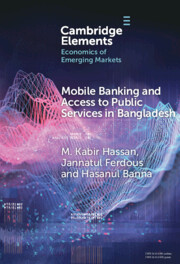Element contents
Mobile Banking and Access to Public Services in Bangladesh
Published online by Cambridge University Press: 26 February 2024
Summary
- Type
- Element
- Information
- Online ISBN: 9781009447089Publisher: Cambridge University PressPrint publication: 21 March 2024
References
- 5
- Cited by

